H d’oh TV: Watching With The Simpsons in High Definition
R. Colin Tait / FLOW Staff
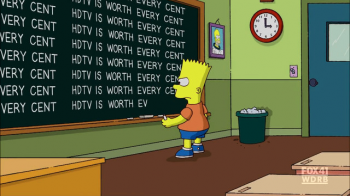
Having grown up with The Simpsons over the last twenty years, it’s easy to assume the show has a largely fixed, rather than dynamic meaning. Conventional wisdom poses that the show’s glory years are well behind it having peaked with Conan O’Brien’s stewardship in the early nineties. However, as the show continues to expand its boundaries (something that Jonathan Gray calls its extratextual “overflow”)1 we need to ask new questions of the series as it spills into other media industries, particularly with The Simpsons Movie, The Simpsons Video Game, The Simpsons Ride at Universal Studios Florida and the show’s conversion to the HDTV format in 2009.
As recent years have marked considerable corporate investment in The Simpsons brand by its News Corporation parent company – presently it occupies the opening 8pm time-slot in Fox’s “Animation Nation” Sunday night programming – it is necessary that we take another glance at the series, not only to assess its continual value as a satirical mirror of the absurdities of American life but also its increasing value as a corporate product. The Simpsons themselves might not age, but the show continues to evolve, having entered a new phase in the life of its brand identity with the advent of new technologies. Oh, and it’s still funny too.
The series’ recent conversion to the High Definition Television (and widescreen) format has given the 20 year-old show a major face-lift by updating its classic opening sequence. This change has two effects. First, it acts as a public record, documenting American Television’s conversion to digital and HD formats while following U.S. federal government mandates. Second, it retools the show to make way for more detailed animation, expanded storytelling and new jokes by utilizing the previously unused edges of the frame.
[youtube]http://www.youtube.com/watch?v=rb82TUYoa88[/youtube]
Far from simply adding a new hat to an old Malibu Stacy doll (as it were) the dynamic new opening raises several issues. For years, Pan and Scan (the process by which a film is converted to match the TV format) has butchered the outer edges of the movie frame for conversion to TV. It is also this process that is understood as the point of absolute difference between the two formats. Put simply, traditional TV resembles a square (The 4:3 ratio, such as the one that the Simpson family used to possess) while film is displayed in widened rectangle (16:9). Thus, The Simpsons’ conversion to HD might change the actual meaning of TV by rendering these differences problematic. Where we used to know that we were watching “TV” precisely because of the square format of the image, HDTVs’ resemblance to film, and its shared rectangular shape, poses us problems when looked to as differentiated products.
The Simpsons Movie identifies itself as a different product early on the film, reflexively shifting from the dimensions of TV to those of film in the opening moment.
(For my fellow international residents, who are blocked to hulu access portal, view the clip here)
As we can see in this clip, the familiar opening is changed from the outset, as the 4:3 ratio is immediately corrected by Professor Frink in his flying machine as he sings along to the familiar theme, adding “movie…on the big screen” and expanding the image from the standard TV dimensions to the widescreen format. The rest of the sequence can be seen as taking full advantage of the technological and visual superiority afforded in the movie theatre (as does the final credit sequence, which has us sitting in the theater with the Simpsons family as they comment on the names). This sequence also brings us through a sophisticated (nearly) three-dimensional version of Springfield, complete with the familiar settings of the town which literally pop-up and out at us in the opening minutes. The humor of the scene comes from its playfully familiar relationship to the TV show’s earlier sequence, providing us with Bart’s chalk-board writing “I will not download this film illegally” and ending with a stereo mix of Green Day’s version of the theme song. Moreover, it is almost as if this sequence highlights the superiority of film over TV by showing all of the things that TV couldn’t do.
With the advent of HD technology and the show’s shift to widescreen, these advantages have changed significantly. The Simpsons’ HD opening, which debuted on February 15th, 2009, pushes the theatrical version even further, taking full advantage of the expanded screen to reflexively comment on the action in the outer reaches of the 16:9 screen size.
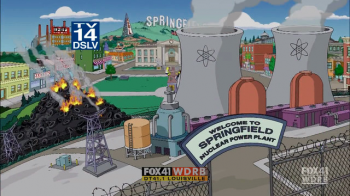
The first thing we notice is that this sequence more fully resembles The Simpsons Movie than its TV precursor. Plus, the animation far better than anything we’ve seen in the twenty-year-old sequence that we have doubtless watched countless times. We should note the transformation of the sequence to include action in the outer edges of the frame. The conceit here is that this action had always been taking place, but had been trimmed to accommodate the (Pan and Scan) demands of syndicated television.
Most shocking of all is the disappearance of the Simpsons’ beloved, rabbit-ears laden TV (was it a Magnetvox, a Fony?). The family, which has resisted almost every technological advance of the past twenty years (computers, cell phones, even cable TV) now has a flat, widescreen TV, haphazardly hung on the wall (by Homer himself no doubt) only to fall off at the end of the sequence.
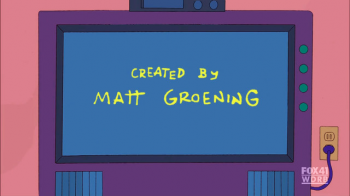
Widescreen TVs are abound throughout the sequence, perhaps reflecting Springfield’s gradual (and, indeed, federally-mandated) conversion to digital formats and the proliferation of wide screens in almost every public space (including bars, gyms, taxis, iphones) in the real world. This can most clearly be seen in a shot of Bart’s skateboard past a TV shop, where Krusty’s smile is marked on a pyramid of the now ubiquitous wide screen TVs.
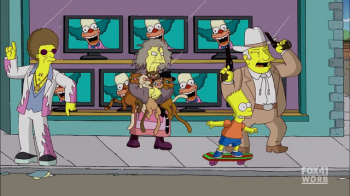
A breakdown of the opening’s new contents reveal that it retroactively changes the meaning of the original by behaving as if someone had edited out details of the sequence that had always been there. These fixtures were seemingly omitted in the shift from an imagined widescreen version as it was converted from the 16:9 to 4:3 screen format. While this may seem like a slightly contentious statement at first, we need only look at the new features and camera movements in this new opening to see how this effect operates.
The familiar image of Homer working with the nuclear rod is our first cue, as the expanded frame shows Lenny and Carl on the extreme right, implying that they had been there all along but were excised to concentrate on the main action of Homer’s accident.
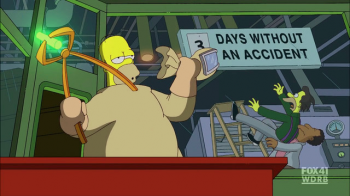
This effect occurs again in the grocery store with Marge and Maggie, as a subtle camera move reveals that Baby Gerald (Maggie’s unibrowed nemesis) had been there for her to shake her fist at him the entire time.
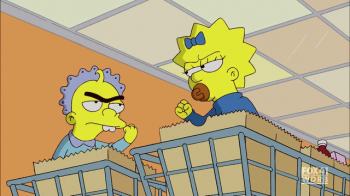
Finally, on the drive home, a previous punchline – Maggie driving the family car – is expanded to reveal that Grandpa Simpson was probably in the vehicle for the familiar journey.
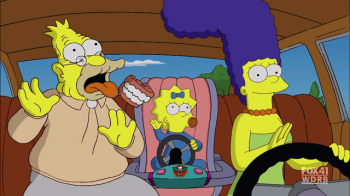
Without overstating the significance of this new opening, I hope that this analysis offers several questions worth following up on for future consideration.
The first of these asks whether the series’ (and more generally, television’s ) conversion to HD actually changes its ultimate meaning as it moves from the 4:3 to 16:9 formats. I think that it’s fair to say that The Simpsons‘ new opening effectively asks this question by placing restaging familiar action but by enhancing it with the edges of the frame. Thus, by deliberately utilizing the new aesthetics of HD the sequence foregrounds these concerns (in the form of Bart’s chalkboard scrawl “HDTV is worth every cent”) in addition to the proliferation of (wide) screens throughout.
Interestingly, the sequence performs the function of advertising the technology by demonstrating the format’s expanded capacity to show a better image and make better use of screen space. The “HD-ness” of the opening serves a similar role as the best selling Blu-Ray and HDTV DVD series Planet Earth – it sells the technology of better picture and sound while employing the new features that the new technology affords. Both are great selling points for new TV buyers.
That the jokes of the new sequence are all dependent on the outer-edges of the frame in relation to the all-too-familiar older sequence is further evidence that specific changes are taking place. The sequence’s expanded length and diversity (in some episodes it is nearly three minutes long) and content speaks to a larger understanding of the series’ continued innovation at televisions’ literal and figurative boundaries.
Following Jonathan Gray’s important work on the show’s boundary spillage (and textual excess) into video games and postage stamps, we might see the series’ expansion in the past three years – first to the movie screen (The Simpsons Movie, 2007) then to rides and into the expansion of the TVs frame – as accommodating the federally-mandated conversion to digital while expanding to create new cultural meanings in an increasingly confusing era of TV/Film/Videogame/Theme Park convergence.
[youtube]http://www.youtube.com/watch?v=ZTUTkcG28Vc&feature=related[/youtube]
Perhaps we can view The Simpsons’ continuing expansion across media industries as a test case for understanding how media empires work by investigating one of its most stable, informative and entertaining artifacts. The show’s ongoing employment of new technologies and integration into newer media industries such as movies, videogames, theme park rides and HDTV formats force us to ask questions about what the franchise, and ultimately whether series’ meaning actually changes with its incorporation of these innovations.
And while we’re at it, we should probably stop to enjoy the series, as this new corporate investment equals crisper animation, stronger writing, biting satire and better access across media industries than ever before. Thus, to borrow a phrase from Gray, we’re no longer merely “Watching with The Simpsons” but enjoying the experiences of playing with them, riding with them and experiencing new technologies with them as well.
Image Credits:
1. HDTV is Worth Every Cent
2. A Wider Springfield
3. The Simpsons’ New Widescreen TV
4. Bart, The Crazy Cat Lady and Krusty in Widescreen
5. Homer, Lenny and Carl
6. A Previously Unseen Baby Gerald
7. Grandpa Simpson Revealed
Please feel free to comment.
- Gray, Jonathan, “Springfield Sprawl” http://mediacommons.futureofthebook.org/imr/2009/04/26/springfield-sprawl-ad-game-movie-show see also Watching With the Simpsons: Television, Parody and Intertextuality, New York: Routledge, 2006. [↩]
How could I not rush to read this piece? :-) Neat work, Colin. I’m intrigued by how heavily laden with meaning opening credit sequences often are, especially when they change and thus refer to the previous iteration(s). I love how you point out how the HDTV version of The Simpsons’ sequence works something like a franchise reboot, starting from scratch seemingly yet offering extra layers and shades of meaning that are open only to longtime viewers.
It’s perhaps worth noting, too, that last summer the Simpsons animators in Burbank had new computers that allowed them to move over to drawing directly onto the screen, and when I visited the animation studio, there was a palpable sense of excitement from longtime animators who now found their job rejuvenated by this new twist (though, granted, some also found it annoying). So, between the movie, the game, the new screens, the HDTV, etc., the show might be experiencing a minor rebirth.
I, too, have felt a refreshed interest in THE SIMPSONS since its conversion to HD/widescreen. Thank you, Colin, for your insights about the significance of the program’s new width — especially in the iconic credits sequence. It is indeed interesting to consider how the writers/directors have “revealed” new material previously “concealed” by the 4:3 format.
In addition to providing more visuals on the margins, I find that THE SIMPSONS in high definition also provides more visual details WITHIN the margins. That is, the higher definition allows its makers to cram more sight gags within the image — gags that would be lost at a lower resolution. I find myself pausing my DVR (even more than I used to) to inspect details of the image — e.g., the magazines on the racks when Marge checks out of the grocery store. The move to HD has also been a move to higher visual density.
And one comment about comparing the aspect ratios of old SIMPSONS (4:3 or 1.33:1) with new SIMPSONS (16:9 or 1.78:1) and THE SIMPSONS MOVIE. The movie release was in 2.35:1 widescreen (according to IMDb). This article could make the difference between 2.35 widescreen and 1.78 widescreen a bit clearer. When the SIMPSONS movie is shown on a widescreen TV it must be reduced, either through pan-and-scan or letterboxing. That is, HDTV widescreen is still not as wide as theatrical, anamorphic widescreen (2.35 or 2.4 to 1).
Also, the movie’s gag with Frink echoes a similar gag at the start of Frank Tashlin’s WILL SUCCESS SPOIL ROCK HUNTER?
Just a short note to add that the show beat Amazing Race and Extreme Makeover: Home Edition in the Nielsens last night, the second week in a row in which its ratings have done quite well. Clearly, there’s some (resurgent?) interest still in the show
Thanks so much for the feedback!
Following your comments Jonathan, it appears that the show might be positioning itself for a major comeback.
I don’t know if either of you have had a chance to check out The Simpsons Ride at Universal Studios Florida, but it is a really impressive (not to mention expensive looking – and fun) simulator ride which seems to me to be representative of someone’s (well, several corporations’) desire to elevate the franchise to the status of a corporate “tentpole” release on par with Batman, etc…I think that all this renewed investment has reminded people that the show is still relevant again (or perhaps always was).
Jeremy: Thanks a lot for your input, particularly about the aspect ratios. As for the grocery store, I was very torn about either showing baby Gerald – or tomacco juice, which is probably my favourite product of all time.
You can find a pretty good shot by shot breakdown of the sequence here, should you need some help finding some of the details
http://www.simpsoncrazy.com/opening/hd
Great piece, Colin and certainly a fascinating topic!
I wonder how issues of movement and animation have been affected by switching to hi-def. If image detail and clarity has improved considerably as a result of hi-def (and continued technological strides in computer-based animation), I wonder how this ultimately impacts animation as a form, which has long been conceptualized by animators and scholars as a movement-based medium. Watching the show now, after treasuring older episodes in syndication and on DVD, the nature of the characters’ movements makes the show look and feel altogether different.
Though perhaps only tangentally related, to me your article and the myriad of other issues it raises suggests a potential kinship between your work here and John Cline’s Flow column about action sequences filmed on digital camera and the mind’s inability to perceive movement.
It was “Magnetbox and Sorny” actually. C’mon Colin, get your facts straight :)
But appropriately enough, that episode was called “Scenes from the Class Struggle in Springfield” — is HD creating another front in the digital divide? HD might be worth every penny but not all of us have enough pennies. You (and the commentators) raise many great points here from interpretative, aesthetic, and technological standpoints, but what about the inherently oppressive nature of requiring really expensive equipment to continue enjoying our most beloved sitcom? Sure, the animators attempt to maintain central framing that lets us non-HD proletarians still follow along, but I’m increasingly having to hear dialogue from characters off screen and I’m definitely missing a lot of the HD sight gags. As Jeremy notes, “higher definition allows its makers to cram more sight gags within the image — gags that would be lost at a lower resolution”. Well what about the vast majority of us watching at low resolution that are missing out on all these new jokes? Much like how internet service providers have little economic incentive to increase access to the lower classes (more money to be made from selling more expensive service to the upper classes), thereby solidifying the digital divide (a reductive explanation for a complex process), might HD Simpsons be engaging in a similar practice?
Thanks for this article, Colin.
Since making the switch to HD, I have found my status as a cinephile/tastemonger rather compromised by my desire to watch the biggest, splashiest & “cleanest” images.
As a sitcom, The Simpsonswas burdened by content (and concerns of realism, etc.)! And so, the gradually decline in writing led to complaints over the past 10 or so years.
Groening’s creation has been institutional art for some time (the “symbol of an evil corporation”). Now that the show’s selling point (affective locus) is merely the surface of the image, it has finally shed its indexical quality to strive toward the iconic.
The cleverness of adding gags to the edges of frame previously unviewable in 4:3 is right up the Simpson’s alley. It demonstrates how the Simpsons has continued to evolve and embrace cultural and technological change over the past two decades, but there’s another aspect to the expanded HD gags that interests me.
Previously, in the standard definition version of the opening credits, when Maggie is passed over the barcode scanner, there’s a flash of light on the screen displaying the price. Diehard Simpson fans could tell you precisely what price was displayed on the screen because they had used their VCRs to advance frame-by-frame through the sequence for the one frame in which the price was visible. Now, one of the subtle jokes added to the HD opening is how clear and easy it is to read the price.
I think this says something about the nature of the Simpsons and how it’s audience has shifted over the years. The show has always been layered with extra jokes for super-fans dedicated enough to spend more time mining for them. And back in the early years, though the Simpsons was extremely popular, it was still considered counter-cultural and subversive. My mom wouldn’t let me watch the Simpsons for the first few years it was on – nor could many of my friends. But in just a few years, the culture shifted so much, that the Simpsons no longer seemed as subversive and shows like Beavis and Butthead and South Park took that mantle. In fact the Simpsons has become more and more a show that upholds traditional values like family and community more than it lampoons.
The Simpsons has become more and more mainstream over the years, and in turn more accessible to a larger audience. I think this is one of the reflections of the new title sequence. The aspects of the show that were once only for the hardcore Simpsons fans, are now on display and easily accessible to all (with HDTVs).
I enjoyed the article and appreciated the analysis of the frame-size/audience perspective relationship. The Simpsons excels in deriving humor from the hypocrisies of normally accepted social conventions, and its embracing-while-skewing of HD is one of the more successful gags the show has had in a while.
However, I think your assessment over-embraces the positive aspects of the “new” Simpsons without recognizing what the show has lost in the transition. While the show has become more visually creative in the HD age, as you point out in the title sequence, it has traded in a good potion of the character-building and story-telling creativity that it built its reputation on over its nearly decade long prime. The examples you point to in the titles—Grampa asleep in the car, Maggie’s nemesis, even the tire fire—are all repeated jokes where nothing significant has been added or changed to enhance the gag. The show, in general, follows the same template of referential jokes and recycled storylines.
During its prime, the Simpsons was constantly innovating with experimental story structures—“22 Short Films About Springfield”, for example—and new characters. In the larger context, the ever-heightening importance of image quality to the average audience television and cinema audience causes the writer/creators to focus more attention on imagery and less on story. For whatever reason, there appears to be an inverse relationship between high-quality images and innovative storytelling, with images winning handily on the big screen and threatening the same in television as well. While it is right to acknowledge the Simpsons move into the newer, brighter HD future as a step toward greater relevancy, it is also wrong to ignore what the show has lost.
Pingback: Lisa Simpson, saxophone player « Feminist Music Geek
Pingback: Elokuvallisia huomioita maailmalta 14.09.2010 // Kuva
Je vous remercie pour cet article riche en informations. Je dois dire que je ne regrette en rien de m’être abonné à votre weblog. A bientôt.
Just an FYI — “The Simpsons Movie” is wider (2.35:1) while the TV show is 1.78.1 (16:9). You really can’t compare the two to each other. The animators of the film had 20% more width than the HD TV version to work width. This image will show you the difference.
http://cw.routledge.com/textbo.....GBedit.jpg